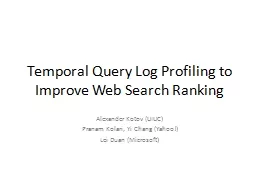

Alexander Kotov UIUC Pranam Kolari Yi Chang Yahoo Lei Duan Microsoft Motivation Improvements in ranking can be achieved in two ways Better featuresmethods for promoting highquality result pages ID: 240175
Download Presentation The PPT/PDF document "Temporal Query Log Profiling to Improve ..." is the property of its rightful owner. Permission is granted to download and print the materials on this web site for personal, non-commercial use only, and to display it on your personal computer provided you do not modify the materials and that you retain all copyright notices contained in the materials. By downloading content from our website, you accept the terms of this agreement.
Slide1
Temporal Query Log Profiling to Improve Web Search Ranking
Alexander
Kotov
(UIUC)
Pranam
Kolari
, Yi
Chang (Yahoo!)
Lei
Duan
(Microsoft)Slide2
Motivation
Improvements in ranking can be achieved in two ways:
Better features/methods for promoting high-quality result pages
Methods for filtering/demotion of adversarial and abusive content
Main idea: temporal information can be leveraged to characterize the quality of content.Slide3
Learning-to-Rank
Well known application of regression modeling
Learn useful features and their interactions for ranking documents in response to a user query
Features: document-specific, query-specific or document-query specificSlide4
Web Spam Detection
Ranking of search results is often artificially changed to promote certain type of content (web spam)
Anti-spam measures are highly reactive and ad hoc
No previous work explored the fundamental properties of spam hosts and queries Slide5
Main idea
s
earch
l
ogs
q
uery and host
p
rofiles
P
1
time
P
2
P
3
P
n
m
easures
1
m
easures
2
m
easures
3
m
easures
n
time
a
ggregate into temporal featuresSlide6
Main idea
Temporal changes are quantified along two orthogonal dimensions: hosts and queries
Host churn: measure of inorganic host behavior in search results
Query volatility: measure of likelihood of a query being compromised by spammersSlide7
Host churn
Goal: quantify the temporal behavior of hosts in search results for different queries
Profile includes
4 attributes: query coverage, number of impressions, click-through rate, average position in search results)
Idea: spamming and low-quality hosts exhibit inorganic changes in their appearance in search results of different queriesSlide8
Host churn
Host churn:
Metrics:
Logarithmic ratio
Log-likelihood test
c
hurn metricSlide9
Host churn
n
ormal host
spam hostSlide10
Query volatility
Goal: identify queries with temporally changing behavior;
Profile: number of impressions, sets of results and click-
throughs for a query at different time points;Idea: spammed or potentially
spammable
queries exhibit highly inconsistent behavior over time. Slide11
Query volatility
Query results volatility: spam-prone queries are likely to produce semantically incoherent results over time
Query impressions volatility: buzzy queries are less likely to be spam-prone
Query clicks volatility: click-through densities on different search results positions are more consistent for less spam-prone queries
Query sessions volatility: users are less likely to be satisfied with search results and click on them for spam-prone queriesSlide12
Query results volatility
Non-spam
SpamSlide13
Query results volatility
Volatility score:
Measures:
Jaccard
distance:
KL-divergence:
volatility metricSlide14
Query impressions volatility
Buzzy queries are less likely to be spam-prone, since buzz is a non-trivial prediction
Given time series of query counts, the ``
buzziness’’ of a query is estimated with Kurtosis and Pearson coefficients Slide15
Query clicks volatility
Less-spam prone,
navigational
queries
have consistently higher density of clicks on the first few search results
Click discrepancies are captured through mean, standard deviation and Pearson correlation coefficient for clicks and skips at each positionSlide16
Query sessions volatility
Fraction of sessions with one click on organic search results [over all sessions for the query]
Fraction of sessions with no clicks on organic or sponsored search results
Fraction of sessions with no click on any of the presented organic resultsFraction of sessions with user clicks on a query reformulation Slide17
Spam-prone query classification
Spam-prone queries (284 queries)
Filter historical Query Triage Spam complaints
Non spam-prone queries (276 queries)
Gradient Boosted Decision Tree Model
10-fold cross-validationSlide18
Results
SPAMMEAN (baseline) – mean host-spam score for a query, developed over the
years
VARIABILITY – features derived from temporal profiles, language-independent
Combined model most effective, variability by itself very effectiveSlide19
Results
Position, click and result-set volatility are the key features
SPAMMEAN continues to be ranked as the top feature in the combined model Slide20
Results
The distributions of query
spamicity
scores for queries containing spam and non-spam terms are clearly different Key terms in queries on both sides of the
spamicity
score range indicate the accuracy of the classifier
“
adult
”-
queries
“
general
”-
queriesSlide21
Ranking
MLR ranking baseline (MLR 14)
1.8M
query-
url
pairs used for training
Test on held-out
data-set (7000 samples)
Query
spamicity
score is added to all
production
features
Evaluation using Discounted Cumulative Gain (DCG)
metric
Spam Query Classification as a new feature
Covered queries are 50% of all queriesSlide22
Results
The coverage of the
spamicity
score is 50%, hence the overall improvement across all queries is not statistically significant
Queries covered with
spamicity
score show
signifcant
improvement
Spamicity
score feature ranks among the top 30 ranking features
Slide23
Conclusions
Proposed a simple and effective method to characterize the temporal behavior of queries and hosts
Features based on temporal profiles outperform state-of-the-art baselines in two different tasks
Many verticals are similar to spam: trending queries. Slide24
Future work
More in-depth analysis of temporally correlated verticals: separate ranking function
Qualitative analysis of spam-prone queries along semantic dimensions
Shorter time intervals for aggregation